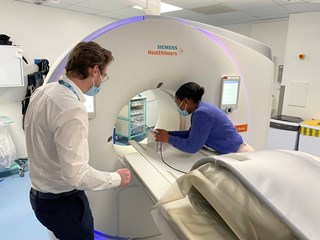Diagnostic Radiology

Diagnostic radiology is a method of finding out what is wrong with a patient by seeing through the affected part of their body using X-rays. A diagnosis is made either from two or three plain X-ray images (radiographs), from a series of images produced by CT (computerized tomography) scanning or moving X-ray images called fluoroscopy.
Who needs diagnostic radiology?
 Patients with suspected broken bones, shadows on the lungs, gall bladder or kidney stones, gastric ulcers, tooth decay, or jaw disease often have a radiograph taken. Dentists regularly check for problems below the gum line using radiographs. CT scans of the head are useful for patients with suspected brain tumours, who have suffered a stroke, or who have bleeding or swelling of arteries in the brain. CT scans can also be used to identify cancerous tumours and investigate disease or internal trauma as a result of serious accidents. As well as still pictures, moving X-ray images, known as fluoroscopy, are used to guide doctors inside the body during orthopaedic surgery and during procedures to clear blockages in arteries that feed the heart.
Patients with suspected broken bones, shadows on the lungs, gall bladder or kidney stones, gastric ulcers, tooth decay, or jaw disease often have a radiograph taken. Dentists regularly check for problems below the gum line using radiographs. CT scans of the head are useful for patients with suspected brain tumours, who have suffered a stroke, or who have bleeding or swelling of arteries in the brain. CT scans can also be used to identify cancerous tumours and investigate disease or internal trauma as a result of serious accidents. As well as still pictures, moving X-ray images, known as fluoroscopy, are used to guide doctors inside the body during orthopaedic surgery and during procedures to clear blockages in arteries that feed the heart.
How does it work?

Radiographs are like photographs, but unlike light, X-rays can pass through human tissues like skin and muscles. During an X-ray examination, the patient is put in front of a photographic film, or a digital detector similar to those used inside digital cameras, that can record the X-ray picture. X-rays are then fired through the part of the patient’s body needing to be examined. Any of these X-rays that pass through the body are recorded on the film or detector. Dense tissue, like bones, stop lots of X-rays and appears white on the final image. Less dense parts of the body, such as fluids, muscles and organs, appear as different shades of grey. Any areas of the image where lots of X-rays pass through the body appear black. In fluoroscopy, the X-rays hit a phosphor plate in front of a video camera or digital detector to give a moving X-ray image.
In CT scanning, (which is sometimes called 'CAT' scanning), X-rays are taken at many different angles through our bodies, and combined by computer to give slices through the body which cannot be seen on plain X-rays. Some CT and fluoroscopy scans need us to swallow or be injected with substances called 'contrast agents' that help certain tissues and blood vessels show up better in the images. For example a drink containing barium, which blocks the path of X-rays and so shows up white on images of the stomach and intestines, can be given to patients with digestive problems.
Future developments
As in photography, digital imaging and computers are changing diagnostic radiology by making images clearer and able to show problems more easily.
Take a look at the following video for more information: